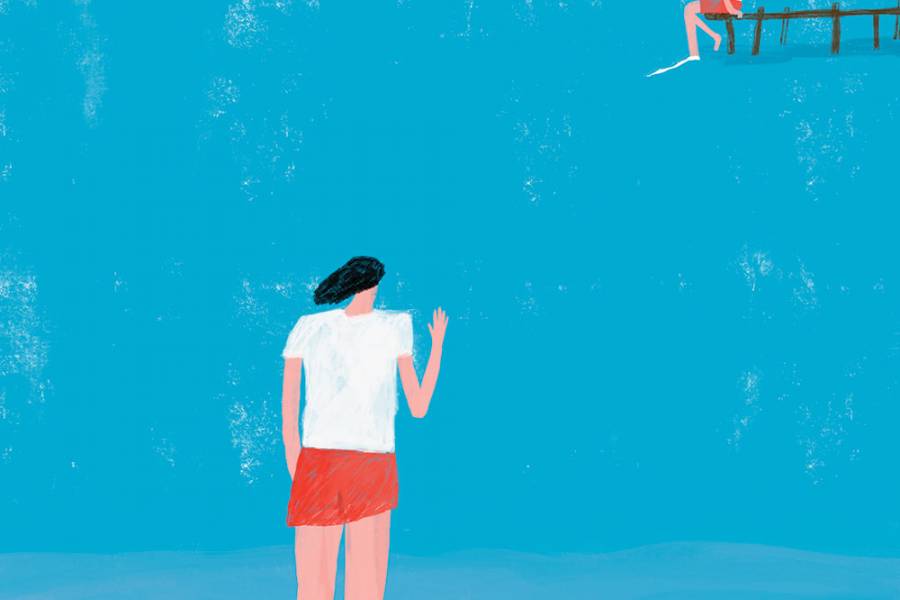Elin Hilderbrand, A&S '91, has written 27 novels including the New York Times bestsellers Summer of '69 and 28 Summers. Her latest, Golden Girl, was released on June 1. She lives on Nantucket Island with her three children.
Island One: Nantucket
I grew up in a blended family of five children, and every year, my father and stepmother would take us to Cape Cod for the month of July. We rented a ramshackle cottage on a sandy lane that led to Cape Cod Bay. The cottage had a sagging screened-in porch, sand between the floorboards, bookshelves crammed with swollen paperbacks. While on the Cape, there were rules we had to follow. There was no showering inside; everyone used the outdoor shower. There was no eating inside; meals were taken out back at the picnic table. If it was sunny, it was a beach day. We would march down the lane right after breakfast and march back in late afternoon. We used to treat the sunset like a Broadway show, getting our seats early, clapping when the sun sank into the blue horizon. For dinner, we would either grill or go out for fried clams and soft-serve ice cream, and play miniature golf. My father would sometimes wake us up in the middle of the night—to walk down to the beach in our pajamas to gaze at the stars—or he would light the candles in the dining room, where we would play midnight Uno. It was an idyllic way to grow up by anyone's standards.
When I was 16, my father was killed in a plane crash—and those magical summers came to an end.
I spent my 17th summer working in a Halloween costume factory in my hometown of Collegeville, Pennsylvania. It was 1986, so I toiled 40 hours a week folding Rambo headbands and assembling "ghoul kits." As I bemoaned my reversal of fortune, I vowed that, as a grown-up, I would find a way to spend every summer at the beach.
Seven years later, I was teaching English at IS 227 in Queens, New York, and had secured a different teaching job in Westchester County for the following year. With the summer free, I sublet my apartment and found a room to rent on Nantucket. The room was in a tiny, cedar-shingled cottage on a side street where I lived with three strangers (one of these strangers would become my bridesmaid and my daughter's godmother). My roommates and I moved the dining room table out to the backyard and strung Christmas lights through the trees above; we drank coffee here every morning to plan family dinners and house parties. I gave up my A-line skirts and pumps for cutoffs and flip-flops; I bought a used 10-speed bike that I rode to the beach, into town, and to the Chicken Box, a legendary dive bar, where I would dance to live bands. That summer was sunsets, Jeep rides, bonfires, and learning how to gracefully cross a cobblestone street; it was lunches by the Summer House pool, skinny-dipping at Cliffside Beach, cutting pale pink New Dawn roses off the rental house's trellis and keeping them in a water glass by my bed.
The following June, I moved to Nantucket for good.
After a few blissful years, I drove halfway across the country to attend the Iowa Writers Workshop, arguably the best writing program in the country. However, once I got to Iowa, I was miserable. I was surrounded by cornfields, silos, and pig farms. I was literally a fish out of water. The university offered free therapy to students, and I would go every week and cry.
"I hope you understand what you have to do," my therapist said.
"What?" I said. I was both hopeful and terrified that she was going to tell me to quit and go home.
"You have to start writing about Nantucket," she said.
Island Two: St. John, U.S. Virgin Islands
It's March of 2012 and I'm writing my novel Beautiful Day when I visit St. John alone for the first time. I say "alone" because my mother took me to the island when I was in high school, and we stayed at the Maho Bay campground. I wasn't much of a camper, but I did remember the natural beauty of St. John and so, as an adult, I was eager to return. St. John and Nantucket have a surprising amount in common. They're both approximately the same size—about 105 square miles. Sixty percent of St. John is owned by the National Parks; about the same amount of Nantucket is held in conservation. There are no stoplights, no chain stores. The way of life is casual. The people are characters. I felt right at home.
In 2016, after spending my fifth spring on St. John, I asked my publisher if they would consider a trilogy set in the Virgin Islands. I was thinking palm trees and coconut shrimp instead of lighthouses and lobster rolls. My publisher was skeptical; they weren't sure I could change locations. But they took a chance, and a contract for the Paradise series was signed. In September 2017, a few months before I was to start writing the trilogy, St. John was rocked to its foundation. Two Category 5 hurricanes ravaged the island—first Irma (a wind storm) and then Maria (a water storm). Many of the beloved haunts of St. John were destroyed, and people that I counted as friends left. I returned to St. John in the spring of 2018, when the island had just started recovering. I decided to write about the St. John I remembered before the storms, and—much to my publisher's surprise and delight—the Paradise series was successful. I worried about writing about an island that wasn't my own; I was borrowing it for the sake of my fiction. I'm happy to say that my timing was excellent and that the first book was published precisely when St. John needed some good PR. Every person I've encountered on the islands has been enthusiastic about the series. If anything, the books may have brought too many visitors—the USVI are having one of their best years for tourism in decades.
When I look back on this "tale of two islands," I wish only one thing: that I could have told my heartbroken 17-year-old self that someday her dream would come true. Someday, she would find a way to spend every summer (and every winter!) at the beach.
Posted in Arts+Culture
Tagged the ocean issue, elin hilderbrand, essay










